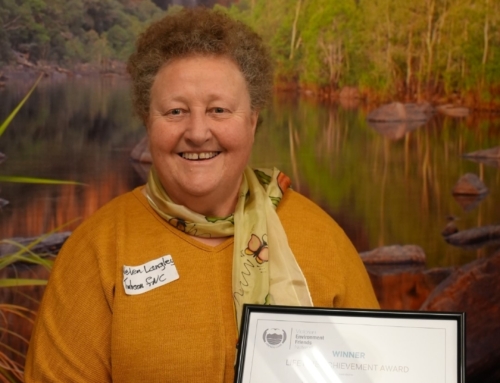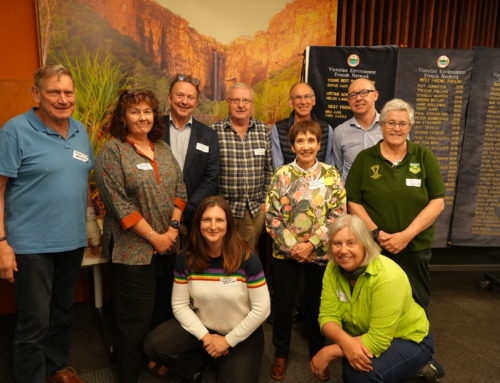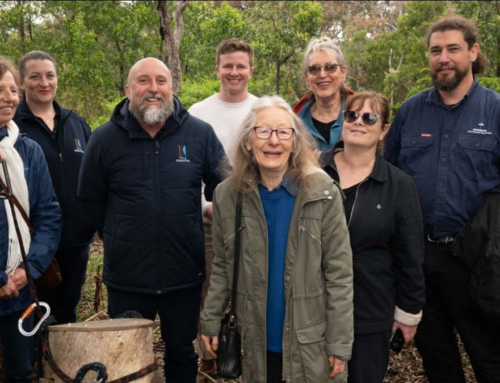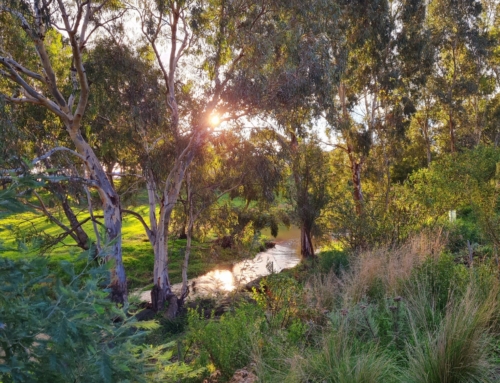
Micro bats returned to the Organ Pipes National Park after roosting boxes were built in the early 1990s.
During December and January 2017 we worked with many Friends Groups to develop portraits of their groups, activities and key achievements.
Together with an introduction by Janet Bolitho, Member, Best Friend Award Panel and Member, Friends of Westgate Park, we forwarded a compendium of 11 group’s portraits to the office of the Minister for Energy, Environment & Climate Change to continue our dialogue about the contribution and importance of Friends Groups.
Continuing our series is the profile of Friends of Organ Pipes. All 11 profiles can be found on our website.
A proud history
The Friends of Organ Pipes National Park (FOOPs) date back to 1972 when the park was proclaimed, solely due to its unique geological features of basalt columns formed by the cooling and cracking of molten lava. Organ Pipes National Park is an area of 153 hectares located in Keilor in the City of Brimbank, about 25km northwest of Melbourne.
Unfortunately, the land surrounding the Organ Pipes, Rosette Rock and the Tessellated Pavement had been severely degraded over the years. Attempts at agriculture on this marginal land had caused the loss of indigenous vegetation and animals, which were replaced with weeds such as boxthorn and artichoke thistle along with rabbits.
Key achievements
FOOPs, initially known as the Maribyrnong Valley Committee in 1972, began a bold attempt to restore the land as near as possible to its pre-European settlement condition.
Important initial research the group undertook was to try to identify what species of plants would have occurred in the area and what soil type, aspect, topography and each plant preferred. They had to mainly rely on the few bits of remnant indigenous vegetation that remained along the Maribyrnong valley and surrounding area plus historical records to piece together their plan.
One of those first “Friends”, Barry Kemp, established a map of seven different planting zones to guide the group in their restoration efforts and we still follow Barry’s pioneering planting map today.
Once the Friends knew what to plant and where, they set about the task of propagating new plants from those surviving in the park and surrounding areas. However, before any planting could take place weeds and rubbish had to be removed – over the years the area that was to become the park had become a dumping ground, so one of the biggest hurdles they faced was removing large heavy materials such as car bodies from the steep escarpment.
Before the establishment of the park the only regular visitors to the area were those with an interest in its geological formations, but now that serious attempts were being made to restore the native flora word spread and botany teachers and students as well as the general public would come along on working bees to help out. A diverse membership of academics, white and blue collar workers as well as retirees and students was established.
Today there are around 40 members on the books, although, like all Friends Groups, just a dedicated few regularly come to the work days.
Restoration
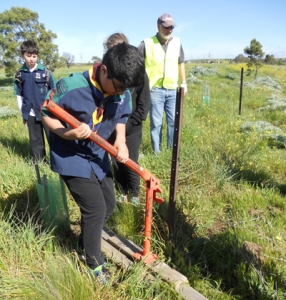
1st Taylors Lakes Scouts group working at the park September 2016.
The restoration over the past 40 years has been quite successful and many native animals have returned. These include Eastern Grey Kangaroos, Black Tailed Swamp Wallabies, Echidnas and filmed for the first time in the park last year, a wombat.
Many trees have matured bringing a host of native birds and aquatic animals back to the once polluted Jacksons Creek. These include Platypus, native fish as well as five species of frogs including the endangered Growling Grass Frog. The establishment of understorey plants and grasses however has proven to be more difficult.
With restoration of habitat and the return of native fauna, activities at the park have expanded to include Sugar Glider monitoring, micro bat monitoring and banding, aquatic micro invertebrate sampling and water quality testing, all done by passionate and dedicated volunteers.
Sugar Gliders were introduced into the park in 1989 and while initially monitored by parks staff it has now become a fascinating project for volunteers that build nest boxes and monitor numbers every season.
Micro bats have returned with the establishment of roosting boxes in the early 1990s on the still young (40 year old) trees. The project has become the longest continuous bat project in Australia and attracts many interstate and overseas students.
Captive breeding of Striped Legless Lizards from salvage operations in the north western grasslands of Melbourne prior to their destruction for development was achieved at Melbourne Zoo in 1998 and released back into the wild in the Organ Pipes National Park.
How the group has achieved these outcomes
Forty years on the challenges that faced the first Friends have changed. Whereas initially they had active support from Parks Victoria staff the knowledge of ecology was very much limited to what was known at that time and trial and error was in many instances the chosen method.
Tools were basic and materials needed not commercially available were made at home. Today, Parks staff are very thin on the ground and the Friends have taken on more of a decision making and managerial role in the park’s ongoing development.
Organised educational tours once done by rangers for schools and universities are now done by volunteers and we simply ask for a donation to help fund our activities. Working bees and fauna projects are also organised within the Friends Groups and interested parties with notification of dates and work to be conducted given to Parks Victoria for approval.
Over the years FOOPs have adapted to meet the challenges of economic, political, social and environmental change. They have, for instance, achieved success in obtaining two years ago a $70,000 federal government grant by having as grants manager a member of the group with business acumen. This enabled them to engage Conservation Volunteers Australia to help plant some 7000 plants. Corporate involvement from Telstra and Pana chocolates was also used. They have also organised with one local council (Brimbank) an ongoing annual Council/Friends environmental agreement for $500 to fund small equipment and training.
Because everyone seems to be time poor nowadays FOOPS has very few volunteers attend working days so are now looking at educational institutions to “adopt” areas of the park to take a form of ownership in its restoration.
One school, Gilson College, has for a couple of years been weeding and planting as part of their year 9 Learning for Life program and has now applied for permits to gather seed and soil samples to further their ecological studies, it is hoped this work will become part of the school curriculum. RMIT has also shown an interest in having the park included in their certificate IV Conservation and Land Management.
A park for the future
The Organ Pipes National Park is testament to what can be achieved not only for education but also the social wellbeing that the natural environment offers. This benefits the general public as well as overseas visitors and because it is so close to Melbourne it is probably the first national park that they visit.
For the future, FOOPS hopes the Organ Pipes National Park will evolve to become more of an educational and research centre that offers flora and fauna in the field studies for schools and universities.
There is a farmhouse ruin in the park that was last habited in the 1920s on land purchased by John Pascoe Fawkner that could be ideal for a school to adopt and maintain. They also have a very much under-utilised visitors centre now officially named The Jack Lyale Conservation Learning Centre after the park’s very first ranger. FOOPS is trying to get schools to use as an on-site classroom after their study tours instead of having to get on the bus and rush back to school.
Friends of Organ Pipes National Park is an Incorporated Association registered with Consumer Affairs Victoria.
- More information: www.friendsoforganpipes.org.au


